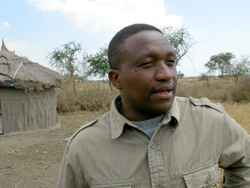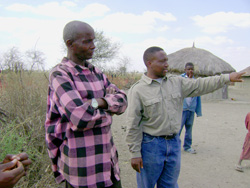
Listen to the radio documentary Survival in the Serengeti, read parts 1, 2, and 3, or join Kerri Miller and Sasha Aslanian for a continuing discussion.

MORE FROM MPR
Palin speaks in St. Paul whileSeptember 3, 2008
Slideshow: Tuesday's protests and arrests
September 2, 2008
RESOURCES
Services
Man-eating Lions
by Kerri Miller and Sasha Aslanian, Minnesota Public RadioMkuranga is a village less than an hour's drive south from Dar es Salaam, Tanzania's historic capital. It's also a place that has seen lion attacks recently. Lions have been known to kill as many as 100 Tanzanians a year.
The landscape is lush and tropical in Mkuranga. But the roads are choked with trucks laden with charcoal, alongside children hauling water and women carrying baskets on their heads. It's getting crowded here, and it's growing more dangerous. Because unlike the Serengeti, where lions have plenty to eat, in Mkuranga, lions are known to prey on humans.

Craig Packer hired Dennis Ikanda to document each deadly lion attack in Tanzania. He's done 400 reports so far. Photo by Sasha Aslanian
Dennis Ikanda is one of Craig Packer's Tanzanian researchers. He's been hired to study the man-eating lions. "It can happen anytime, anywhere and to anyonethese beasts still wander as they wish, amongst people, and are free to prey on humans," says Ikanda. He points to the dense vegetation and sighs, "A lot of simbas here." "Simba" is Swahili for Lion.
"They have taken her!"
Ikanda drives us down the main road, past the open-air markets and people walking along the roadside carrying baskets. We pull up in front of a small cluster of cinder block houses. Ikanda heard a harrowing story that took place here a few months ago. A mother was tending store here so she left her younger daughter, who was less than a year old, in the care of her older daughter. At dusk, the older girl was returning the baby to her mother.

A young girl, less than a year old, was recently taken from this spot by a lion. Photo by Sasha Aslanian
"When she got there," Ikanda points to a nearby cocoanut tree, "she stopped, and put the child down, and started to walk with her, holding her hand, and that's when all of sudden a lion, which was in this bush here, leaped, and grabbed her, and ran away with her." Adults heard the older girl's screams and came running. They went out in the dark to find the lion and the child, but Ikanda says there wasn't much they could do.
The next morning they found the child's remains. "They found pieces of the skull remaining but the child was completely eaten," says Ikanda. So the townspeople did what they do in many parts of Tanzania when wild animals kill their loved ones. They retaliated. This time they slipped rat poison into fresh meat and waited for the lion to show up.
Craig Packer doesn't blame them. "I mean, could you in all honesty say that if somebody was in your backyard, potentially going to be eating your 4-year-old daughter that you'd wait because the government doesn't like the idea of your poisoning a lion?" It's illegal to kill these lions but villagers feel they have little choice. The government can't protect them from attacks.

Bernard Kissui conducts field work in Tanzania while studying for a graduate degree in ecology at the University of Minnesota. Photo by Sasha Aslanian
Small Prey for a Fast Escape
Packer hired Ikanda to study these man-eating lions to find patterns and clues. What time of day did the attack occur? What was the location? Ikanda notices lions have changed their hunting methods to prey on humans. They've learned to grab and run.
"It's a lot easier for them to carry a small child and run away," says Ikanda. Packer seizes on this observation because it's a marked contrast to how lions hunt in the wild. "A lion would never take a calf if it could get an adult because they'd never have to run away, they're never afraid of anything." Packer asks if over time, lions are taking more child victims than adults. Ikanda confirms over the last two years, 85% of the lions' human prey were children.
Packer wants to understand what turns some lions into man-eaters, but not others. So far he suspects the cause is ecological. If a lion can't find space in a national park or hunting area, it will stray outside looking for food. He hopes the work he and Ikanda are doing could help people avoid the kinds of situations that lead to attacks.
Lion Livestock Raids

Zacariah Lukas tells Bernard Kissui about a livestock raid that turned bloody for lions. Photo by Sasha Aslanian
Arusha is Tanzania's gateway to the hunting and safari tourism trade. Just outside the city, Masai herdsmen in their traditional red and blue wool blankets tend their livestock. There are far fewer lion attacks on people in this part of Tanzania. Here, livestock are the easy pickings.
Another one of Packer's longtime researchers, Bernard Kissui, is working on that problem. He takes us to a small village near Tarangire National Park. Packer calls it the "Serengeti from hell" because the park is too small to contain the migration of animals. That means lions spend about half the year wandering outside the park, moving through villages nearby. At night, villagers corral their livestock inside borders of thorn bushes, called a "boma." They must protect their wealth and source of food from prowling lions.
Revenge Killings
But one recent livestock raid here proved disastrous for the lions. Zacariah Lukas comes out of his hut to describe what happened. "So when the lions came, the cattle sort of stampeded out of enclosure. So usually they can smell lions approaching. They just run away from the panic," remembers Lukas.
The lions killed two cattle. The villagers organized a hunting party. "Usually it's a big group of people," says Kissui. "You're talking about 200 or 300 people." The men surrounded the bushes where the lions were hiding and drove them out, killing them with spears. Lukas points to where one lion was killed and gestures that the others were killed farther away. Six lions, an entire pride including its cubs, were killed that night.

Kissui says wire fences work better than piles of thorn bushes in keeping lions away from livestock. Photo by Sasha Aslanian
These sorts of revenge killings worry Bernard Kissui and Craig Packer. Lions bring much needed much money from hunting and tourism to the country but few villagers see this benefit. As Packer sees it, with a growing human population, conflicts with wildlife will only increase. Kissui's research on these livestock raids is aimed at giving people data that can help them reduce the warfare with lions.
Wire Fences Stronger than Thorn Bushes
Kissui hopes strengthening livestock pens will mean fewer revenge killings. It's a simple solution, but Zacariah Lukas seems hesitant. Trading even one cow to buy the wire is more than he can afford. He says he plans to pile even more thorn bushes around his animals to keep the lions out at night.

Masai farmers show the platform on the edge of thier fields where they sleep to guard against elephants. Photo by Sasha Aslanian
Six Ton Pests
Lions aren't the only wild animals causing trouble for local people. We head west to Tingatinga, a village that sits in the rain shadow of Mount Kilimanjaro. The volcanic soil is rich farmland. Here the Masai have changed their traditional culture and become farmers in addition to raising livestock. But the farming comes at a price.
They must sleep out in their fields to guard their corn. A giant platform on the edge of the field is their lookout post. It's rigged with wires and pans to rattle and scare off the elephants. Deeper into the field stands a dummy dressed to look like a farmer.
But the elephants are smart, and not easily intimidated. Our guides demonstrate how men yell, beat tins together and throw burning sticks at the elephants to scare them off but it doesn't always work. Last night, six elephants ate their way through a quarter of one family's harvest.

A farmer surveys the crop damage caused by elephants. Photo by Sasha Aslanian
We can see the broken stalks of corn and enormous footprints in the muddy field. No one was injured. But angry elephants can pick people up with their trunks and hurl them against trees and kill them.
Elephants are an ever-present threat here. Tingatinga sits squarely on a well-traveled elephant path. Alfred Kikote is a Tanzanian researcher who's put radio collars on elephants to track their movements. He shows us a map splotched with bright colors. Tingatinga isn't even visible beneath so many elephant tracks. "Every day, they are there," he says. "The probability of meeting an elephant at night is very high. A serious government would not let people live here."
A Never-Ending Song
But for people living on the elephant path, it's the animals who are the intruders. Joseph Lendiy is a village elder in Tingatinga. He shows us where elephants have eaten the mango tree right in his front yard. "It should have been a big tree like this one but it has always been chowed by elephants."

Researcher Alfred Kikote shows Kerri Miller a map of elephant migratory paths. Photo by Sasha Aslanian
Lendiy says the majority of villagers resent elephants because of they harm people and crops. "But you know," he says with a sigh, "they are there. We have to live with them." When asked whether people shouldn't be living so close to elephants' migration paths Lendiy is firm. "The population of the whole country, and the whole world for that matter has increased. But that being a fact does not remove the right to live-by anybody!" Lendiy isn't leaving.
But Alfred Kikote, the elephant researcher, is pessimistic people like Lendiy who along the elephants' path can avoid future conflicts. He points to his map showing Tingatinga crisscrossed with elephant trails. "Go with this map to the parliament," he urges. "Find land for these people. Otherwise we will be singing a never ending song.""
Continue to part 3.
In The Spotlight
-
The Current Music Blog
Your daily note for good music, news and pop culture. With attempted jokes.






